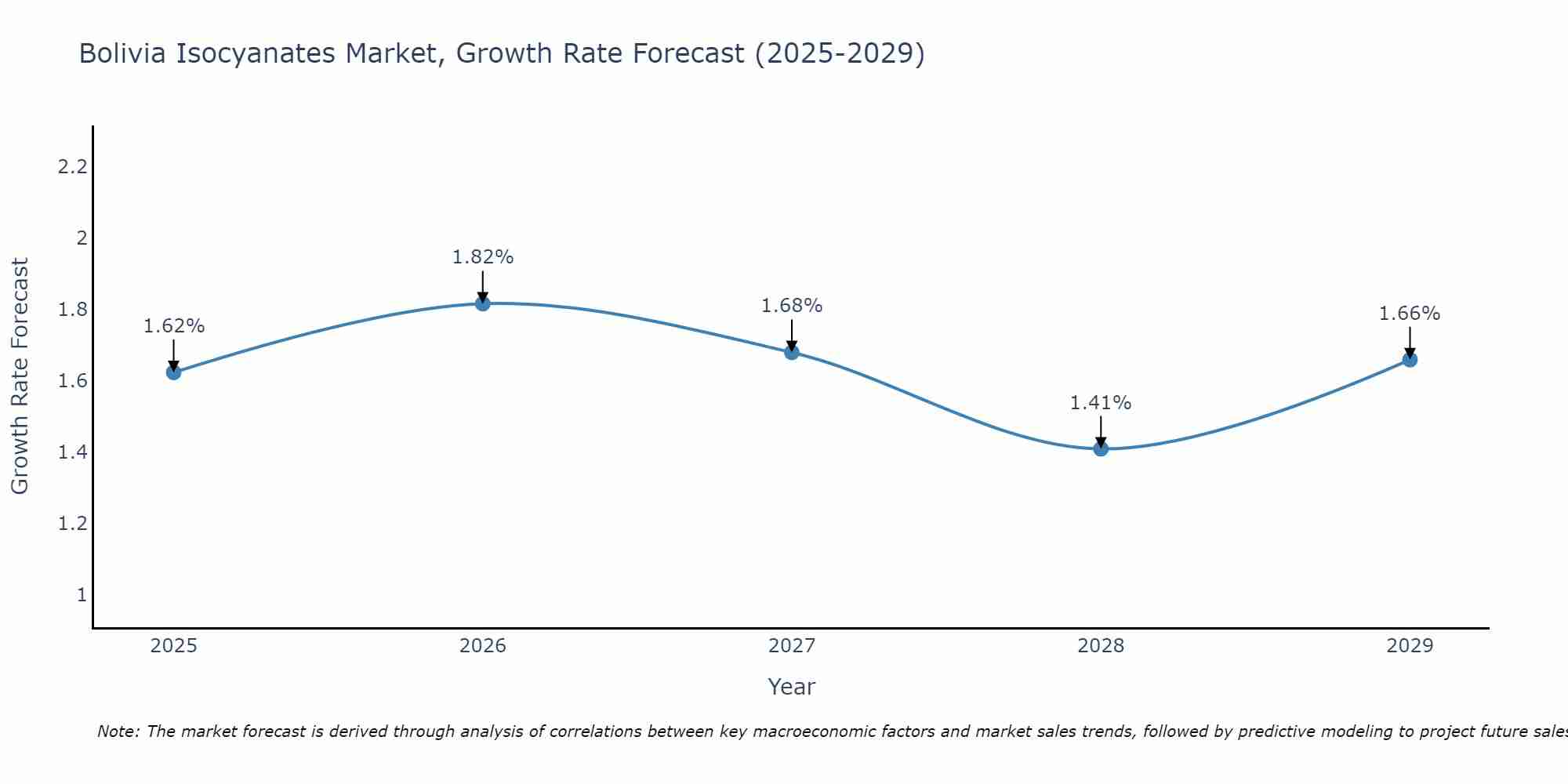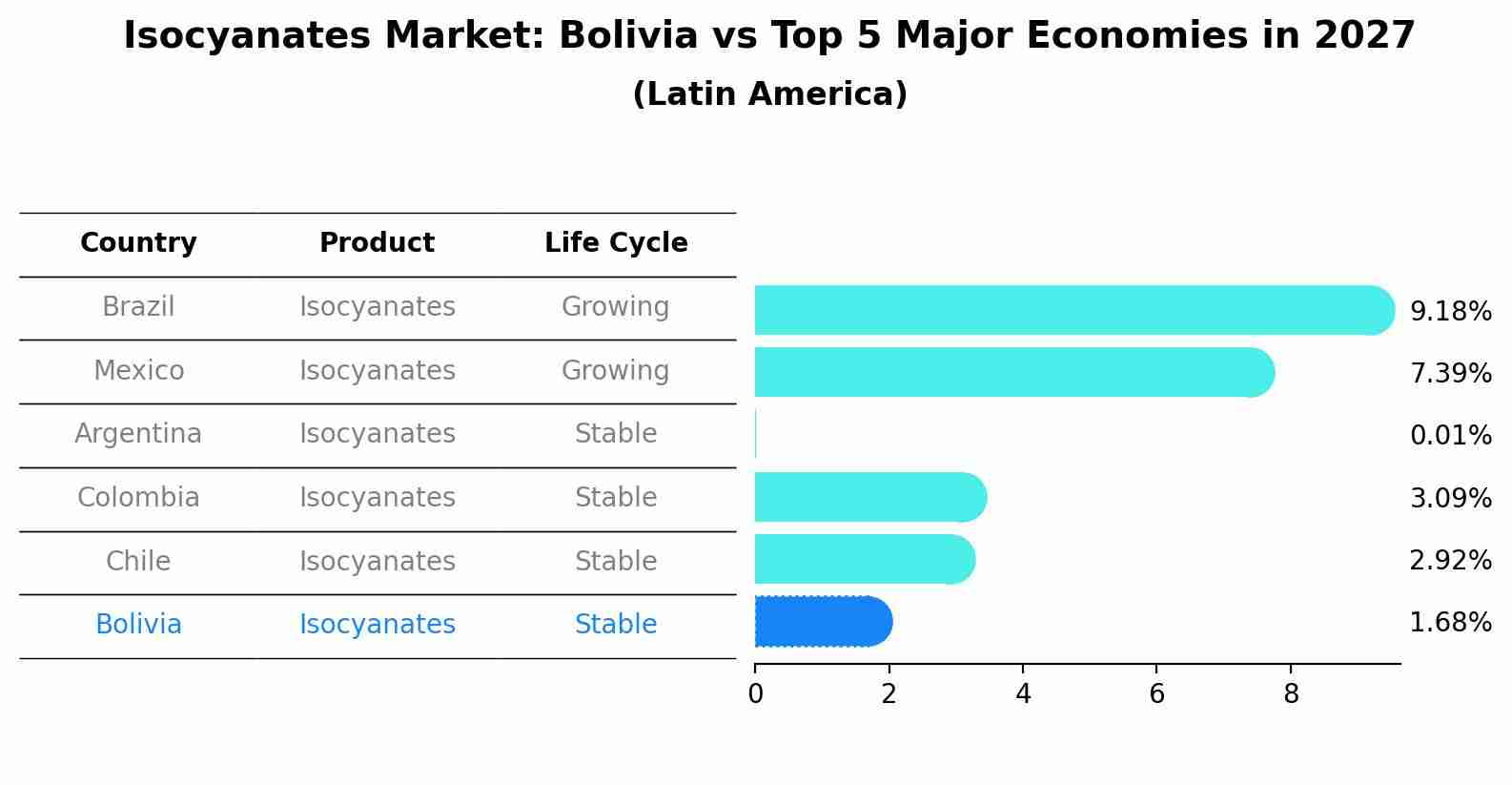Bolivia Isocyanates Market (2025-2031) | Revenue, Size, Growth, Outlook, Value, Analysis, Companies, Share, Industry, Trends, Forecast & Segmentation
| Product Code: ETC4820858 | Publication Date: Nov 2023 | Updated Date: Sep 2025 | Product Type: Market Research Report | |
| Publisher: 6Wresearch | Author: Sachin Kumar Rai | No. of Pages: 60 | No. of Figures: 30 | No. of Tables: 5 |
Bolivia Isocyanates Market Size Growth Rate
The Bolivia Isocyanates Market is projected to witness mixed growth rate patterns during 2025 to 2029. Growth accelerates to 1.82% in 2026, following an initial rate of 1.62%, before easing to 1.66% at the end of the period.

Isocyanates Market: Bolivia vs Top 5 Major Economies in 2027 (Latin America)
The Isocyanates market in Bolivia is projected to grow at a stable growth rate of 1.68% by 2027, highlighting the country's increasing focus on advanced technologies within the Latin America region, where Brazil holds the dominant position, followed closely by Mexico, Argentina, Colombia and Chile, shaping overall regional demand.

Bolivia Isocyanates Market Overview
The isocyanates market in Bolivia is witnessing steady growth, driven by increasing demand in various industries such as construction, automotive, and electronics. Isocyanates, primarily used in the production of polyurethane products, are integral to the manufacture of foams, coatings, adhesives, and elastomers. The Bolivian construction industry, experiencing a boom due to urbanization and infrastructure projects, significantly contributes to the demand for isocyanates.
Drivers of the market
The isocyanates market in Bolivia is driven by the growing demand for these chemicals in the production of polyurethane products used in construction, automotive, and industrial applications. Isocyanates are crucial components in the formulation of flexible and rigid foams, coatings, and adhesives. As Bolivia`s industries seek to enhance product performance and durability, the demand for isocyanates rises. Additionally, advancements in production technologies and a focus on improving material properties and environmental impact drive market growth.
Challenges of the market
In Bolivia, the isocyanates market encounters challenges such as high costs of importing isocyanates and limited local production capabilities. There is a need for investment in technology and infrastructure to support the development and application of isocyanates. Additionally, regulatory issues related to the safe handling and environmental impact of isocyanates pose challenges for market growth.
Government Policy of the market
Government policies might focus on regulating the production and use of isocyanates, including safety standards and environmental protections. Support for innovation in this sector could also be a priority.
Key Highlights of the Report:
- Bolivia Isocyanates Market Outlook
- Market Size of Bolivia Isocyanates Market, 2024
- Forecast of Bolivia Isocyanates Market, 2031
- Historical Data and Forecast of Bolivia Isocyanates Revenues & Volume for the Period 2021-2031
- Bolivia Isocyanates Market Trend Evolution
- Bolivia Isocyanates Market Drivers and Challenges
- Bolivia Isocyanates Price Trends
- Bolivia Isocyanates Porter`s Five Forces
- Bolivia Isocyanates Industry Life Cycle
- Historical Data and Forecast of Bolivia Isocyanates Market Revenues & Volume By Type for the Period 2021-2031
- Historical Data and Forecast of Bolivia Isocyanates Market Revenues & Volume By MDI for the Period 2021-2031
- Historical Data and Forecast of Bolivia Isocyanates Market Revenues & Volume By TDI for the Period 2021-2031
- Historical Data and Forecast of Bolivia Isocyanates Market Revenues & Volume By Aliphatic and Cycloaliphatic for the Period 2021-2031
- Historical Data and Forecast of Bolivia Isocyanates Market Revenues & Volume By Application for the Period 2021-2031
- Historical Data and Forecast of Bolivia Isocyanates Market Revenues & Volume By Elastomers for the Period 2021-2031
- Historical Data and Forecast of Bolivia Isocyanates Market Revenues & Volume By Elastomers for the Period 2021-2031
- Historical Data and Forecast of Bolivia Isocyanates Market Revenues & Volume By Binders for the Period 2021-2031
- Historical Data and Forecast of Bolivia Isocyanates Market Revenues & Volume By End-use for the Period 2021-2031
- Historical Data and Forecast of Bolivia Isocyanates Market Revenues & Volume By Automotive for the Period 2021-2031
- Historical Data and Forecast of Bolivia Isocyanates Market Revenues & Volume By Building & Construction for the Period 2021-2031
- Historical Data and Forecast of Bolivia Isocyanates Market Revenues & Volume By Electronics for the Period 2021-2031
- Historical Data and Forecast of Bolivia Isocyanates Market Revenues & Volume By Others for the Period 2021-2031
- Bolivia Isocyanates Import Export Trade Statistics
- Market Opportunity Assessment By Type
- Market Opportunity Assessment By Application
- Market Opportunity Assessment By End-use
- Bolivia Isocyanates Top Companies Market Share
- Bolivia Isocyanates Competitive Benchmarking By Technical and Operational Parameters
- Bolivia Isocyanates Company Profiles
- Bolivia Isocyanates Key Strategic Recommendations
Frequently Asked Questions About the Market Study (FAQs):
1 Executive Summary |
2 Introduction |
2.1 Key Highlights of the Report |
2.2 Report Description |
2.3 Market Scope & Segmentation |
2.4 Research Methodology |
2.5 Assumptions |
3 Bolivia Isocyanates Market Overview |
3.1 Bolivia Country Macro Economic Indicators |
3.2 Bolivia Isocyanates Market Revenues & Volume, 2021 & 2031F |
3.3 Bolivia Isocyanates Market - Industry Life Cycle |
3.4 Bolivia Isocyanates Market - Porter's Five Forces |
3.5 Bolivia Isocyanates Market Revenues & Volume Share, By Type, 2021 & 2031F |
3.6 Bolivia Isocyanates Market Revenues & Volume Share, By Application, 2021 & 2031F |
3.7 Bolivia Isocyanates Market Revenues & Volume Share, By End-use, 2021 & 2031F |
4 Bolivia Isocyanates Market Dynamics |
4.1 Impact Analysis |
4.2 Market Drivers |
4.2.1 Growing demand from end-use industries such as automotive, construction, and furniture sectors |
4.2.2 Increasing investments in infrastructure projects in Bolivia |
4.2.3 Technological advancements leading to the development of innovative isocyanates products |
4.3 Market Restraints |
4.3.1 Volatility in raw material prices impacting production costs |
4.3.2 Stringent regulations on the use and disposal of isocyanates |
4.3.3 Fluctuations in the global economy affecting export opportunities for Bolivia's isocyanates market |
5 Bolivia Isocyanates Market Trends |
6 Bolivia Isocyanates Market Segmentations |
6.1 Bolivia Isocyanates Market, By Type |
6.1.1 Overview and Analysis |
6.1.2 Bolivia Isocyanates Market Revenues & Volume, By MDI, 2021-2031F |
6.1.3 Bolivia Isocyanates Market Revenues & Volume, By TDI, 2021-2031F |
6.1.4 Bolivia Isocyanates Market Revenues & Volume, By Aliphatic and Cycloaliphatic, 2021-2031F |
6.2 Bolivia Isocyanates Market, By Application |
6.2.1 Overview and Analysis |
6.2.2 Bolivia Isocyanates Market Revenues & Volume, By Elastomers, 2021-2031F |
6.2.3 Bolivia Isocyanates Market Revenues & Volume, By Elastomers, 2021-2031F |
6.2.4 Bolivia Isocyanates Market Revenues & Volume, By Binders, 2021-2031F |
6.3 Bolivia Isocyanates Market, By End-use |
6.3.1 Overview and Analysis |
6.3.2 Bolivia Isocyanates Market Revenues & Volume, By Automotive, 2021-2031F |
6.3.3 Bolivia Isocyanates Market Revenues & Volume, By Building & Construction, 2021-2031F |
6.3.4 Bolivia Isocyanates Market Revenues & Volume, By Electronics, 2021-2031F |
6.3.5 Bolivia Isocyanates Market Revenues & Volume, By Others, 2021-2031F |
7 Bolivia Isocyanates Market Import-Export Trade Statistics |
7.1 Bolivia Isocyanates Market Export to Major Countries |
7.2 Bolivia Isocyanates Market Imports from Major Countries |
8 Bolivia Isocyanates Market Key Performance Indicators |
8.1 Research and development expenditure on new isocyanates formulations |
8.2 Number of patents filed for isocyanates-related innovations |
8.3 Adoption rate of eco-friendly and sustainable isocyanates products in Bolivia |
9 Bolivia Isocyanates Market - Opportunity Assessment |
9.1 Bolivia Isocyanates Market Opportunity Assessment, By Type, 2021 & 2031F |
9.2 Bolivia Isocyanates Market Opportunity Assessment, By Application, 2021 & 2031F |
9.3 Bolivia Isocyanates Market Opportunity Assessment, By End-use, 2021 & 2031F |
10 Bolivia Isocyanates Market - Competitive Landscape |
10.1 Bolivia Isocyanates Market Revenue Share, By Companies, 2024 |
10.2 Bolivia Isocyanates Market Competitive Benchmarking, By Operating and Technical Parameters |
11 Company Profiles |
12 Recommendations | 13 Disclaimer |
- Single User License$ 1,995
- Department License$ 2,400
- Site License$ 3,120
- Global License$ 3,795
Search
Thought Leadership and Analyst Meet
Our Clients
Related Reports
- Afghanistan Apparel Market (2026-2032) | Growth, Outlook, Industry, Segmentation, Forecast, Size, Companies, Trends, Value, Share, Analysis & Revenue
- Canada Oil and Gas Market (2026-2032) | Share, Segmentation, Value, Industry, Trends, Forecast, Analysis, Size & Revenue, Growth, Competitive Landscape, Outlook, Companies
- Germany Breakfast Food Market (2026-2032) | Industry, Share, Growth, Size, Companies, Value, Analysis, Revenue, Trends, Forecast & Outlook
- Australia Briquette Market (2025-2031) | Growth, Size, Revenue, Forecast, Analysis, Trends, Value, Share, Industry & Companies
- Vietnam System Integrator Market (2025-2031) | Size, Companies, Analysis, Industry, Value, Forecast, Growth, Trends, Revenue & Share
- ASEAN and Thailand Brain Health Supplements Market (2025-2031) | Strategy, Consumer Insights, Analysis, Investment Trends, Opportunities, Growth, Size, Share, Industry, Revenue, Segments, Value, Segmentation, Supply, Forecast, Restraints, Outlook, Competition, Drivers, Trends, Demand, Pricing Analysis, Competitive, Strategic Insights, Companies, Challenges
- ASEAN Bearings Market (2025-2031) | Strategy, Consumer Insights, Analysis, Investment Trends, Opportunities, Growth, Size, Share, Industry, Revenue, Segments, Value, Segmentation, Supply, Forecast, Restraints, Outlook, Competition, Drivers, Trends, Demand, Pricing Analysis, Competitive, Strategic Insights, Companies, Challenges
- Europe Flooring Market (2025-2031) | Outlook, Share, Industry, Trends, Forecast, Companies, Revenue, Size, Analysis, Growth & Value
- Saudi Arabia Manlift Market (2025-2031) | Outlook, Size, Growth, Trends, Companies, Industry, Revenue, Value, Share, Forecast & Analysis
- Uganda Excavator, Crane, and Wheel Loaders Market (2025-2031) | Strategy, Consumer Insights, Analysis, Investment Trends, Opportunities, Growth, Size, Share, Industry, Revenue, Segments, Value, Segmentation, Supply, Forecast, Restraints, Outlook, Competition, Drivers, Trends, Demand, Pricing Analysis, Competitive, Strategic Insights, Companies, Challenges
Industry Events and Analyst Meet
Whitepaper
- Middle East & Africa Commercial Security Market Click here to view more.
- Middle East & Africa Fire Safety Systems & Equipment Market Click here to view more.
- GCC Drone Market Click here to view more.
- Middle East Lighting Fixture Market Click here to view more.
- GCC Physical & Perimeter Security Market Click here to view more.
6WResearch In News
- Doha a strategic location for EV manufacturing hub: IPA Qatar
- Demand for luxury TVs surging in the GCC, says Samsung
- Empowering Growth: The Thriving Journey of Bangladesh’s Cable Industry
- Demand for luxury TVs surging in the GCC, says Samsung
- Video call with a traditional healer? Once unthinkable, it’s now common in South Africa
- Intelligent Buildings To Smooth GCC’s Path To Net Zero


















